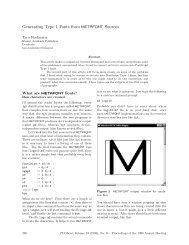Linear Differential Game With Two Pursuers and One Evader
Linear Differential Game With Two Pursuers and One Evader
Linear Differential Game With Two Pursuers and One Evader
Create successful ePaper yourself
Turn your PDF publications into a flip-book with our unique Google optimized e-Paper software.
*<br />
( μ<br />
1H<br />
11<br />
− ε<br />
1H<br />
21<br />
) + ε<br />
1H<br />
21( v2<br />
1<br />
1)<br />
*<br />
( μ H − ε H ) + ε H ( v 1)<br />
z1 f<br />
= z1<br />
+<br />
x<br />
+<br />
2 f<br />
= z<br />
2<br />
−<br />
2 12 2 22 2 22 2x1<br />
−<br />
z<br />
From which, using the initial equality, we can isolated<br />
the evader bounds) :<br />
v<br />
*<br />
2×<br />
1<br />
( z)<br />
=<br />
*<br />
v<br />
2x1<br />
(subject to saturation if<br />
2<br />
( − μ H − z ) τ + ( μ H − z )<br />
1<br />
ε<br />
11<br />
2<br />
H<br />
1<br />
22<br />
τ<br />
P1<br />
2<br />
P2<br />
+ ε<br />
2 12 2<br />
2<br />
1<br />
H<br />
21<br />
τ<br />
P1<br />
τ<br />
2<br />
P2<br />
*<br />
v<br />
2x1<br />
is higher than<br />
*<br />
v<br />
2x1<br />
is relevant outside the 2x1 NEZ <strong>and</strong> is a “reasonable” solution inside the capture zone too. Figure<br />
4 illustrates the optimal trajectories we obtain when the time to go are the same for each pursuer<br />
( μ1<br />
= 2, ε1<br />
= 2, μ2<br />
= 3, ε<br />
2<br />
= 0.85714).<br />
4000<br />
2000<br />
P1<br />
P2<br />
E<br />
0<br />
Distance Y [m]<br />
-2000<br />
-4000<br />
-6000<br />
-8000<br />
0 0.5 1 1.5 2 2.5 3 3.5<br />
Distance X [m]<br />
x 10 4<br />
Figure 4 : Example with evader playing<br />
*<br />
v<br />
2x1<br />
3.3. <strong>Two</strong> on <strong>One</strong> No Escape Zone<br />
The overall 2x1 NEZ is the collection of P1 E NEZ plus P2 E NEZ plus an extra state space area. If<br />
the evader plays in the worst way (from the evader point of view) vi = -sign( z<br />
i<br />
) then a new limit is<br />
under consideration. In addition to z<br />
i max<br />
we define z<br />
i min<br />
:<br />
z1min<br />
= μ<br />
1H11<br />
+ ε<br />
1H<br />
21<br />
z = μ H + ε<br />
2 min 2 12 2H<br />
22<br />
The new 2x1 frontier is then the line between the two intersections that are solution of the equations:<br />
z θ = −z<br />
θ + ΔP<br />
z<br />
( )<br />
1min<br />
( )<br />
1 2<br />
( θ ) = −z1max<br />
( θ ) + ΔP1<br />
2<br />
2 max<br />
P<br />
2 min<br />
P<br />
These two equations give an unique solution τ<br />
2x1<br />
which characterizes the new barrier in the 2x1 game.<br />
Figure 5 shows the boundary of the 2x1 game ( τ<br />
2x1<br />
≈ 7.2 sec. ) with same parameters as in previous<br />
section. The state space area outside the two 1x1 NEZ (blue plain lines) but with τ ≥ τ 2x 1<br />
(vertical red<br />
line) is also now belonging to the 2x1 NEZ.<br />
- 5 -







